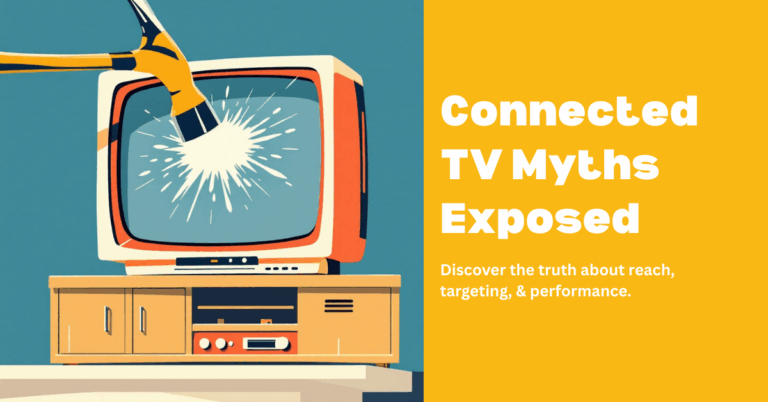
In today’s digital era, opportunities for advertising are more robust and diverse than ever. Connected TV (CTV) has emerged as one of the most engaging platforms for modern marketers. Yet, despite rapid growth in the CTV space, misconceptions persist, and these myths may hamper the effective usage of CTV advertising.
In this article, we’ll bust five common CTV myths, shedding light on the dynamic opportunities that this platform offers. If you would like to read our full CTV Myths guide, learn more here.
 What Is Connected TV?
What Is Connected TV?
Connected TV, essentially, transforms your ordinary television into a smart device, capable of providing a wider access to content via the internet. It redefines the traditional viewing experience, giving users the freedom to stream their favorite shows, movies, and even play games directly through their TVs. As we speak, more and more households are embracing this modern form of televisual entertainment.
However, despite its formidable rise, CTV advertising often falls victim to misinformation and misconceptions. There appear to be a handful of myths in wide circulation that often mislead businesses, especially those considering incorporating CTV into their marketing activities. These myths range from the belief that CTV is purely a tool for general audience awareness to the notion that CTV ads are universally expensive to produce.
Busting Common Misconceptions: CTV is Multiple Funnel Media
Myth: CTV Serves Only the Top Marketing Funnel
The misunderstanding that Connected TV advertising is merely a tool for top-funnel awareness – without serving any purpose deeper in the marketing funnel – is widespread. This misconception likely stems from the comparison with traditional TV, which marketers have primarily leveraged to enhance large-scale brand visibility.
CTV’s Multiple-Phase Capabilities
However, CTV provides advertisers with deeper opportunities than just creating awareness. It operates across the entire marketing funnel, starting from:
- Awareness
- Through consideration and conversion
- To retention
Thanks to its connected nature, CTV offers features such as precise targeting, personalized ad content, and interactive capabilities, catering to more than just brand awareness.
Proof that CTV is More than a Top-of-Funnel Tool
Counterpoints for this myth come from CTV’s capability to engage audiences in ways traditional TV cannot. For one, CTV permits user interaction – clickable ads can direct viewers to a product page or site visit. This direct response capability provides an immediate engagement opportunity and drives conversion, proving that CTV is truly effective in lower parts of the marketing funnel too.
Additionally, CTV permits re-targeting and sequential messaging—critical tools for marketers aiming to retain customers, a significant bottom-of-the-funnel activity.
Therefore, while CTV does indeed play a role in raising top-funnel awareness, its influence hardly stops there. With its ability to penetrate deeper into the marketing funnel, CTV can shape entire marketing campaigns.
Debunking Myths: Understanding CTV Impact Tracking
Myth #2: CTV Impact is Impossible to Track
Common misconceptions have a way of spreading fast. The idea that the impact of Connected TV is impossible to track is one such myth. The source of this belief could be the novelty and complexity of the CTV platform, along with its roots in traditional TV where tracking was indeed daunting.
The Truth Behind CTV Tracking
Contrary to this myth, CTV advertising employs powerful tracking methods and is quite effective at generating useful consumer insights. Some of the measurable parameters include:
- Impressions and completed views
- More advanced metrics like video completion rates, interactions, and conversions
These metrics provide a concrete measure of a campaign’s success. Advanced technologies and attribution modeling can help record direct attributions from TV advertisements by tracking ads at a micro level.
Additional Tracking Features
Moreover, CTV ads support standard digital tracking pixels, enabling advertisers to easily monitor the user journey and record consequent website traffic or conversions. Some of the advantages include:
- Facilitating retargeting strategies based on user interactions with CTV ads
- Comprehensive capture and analysis of viewer engagement, often exceeding other formats
- Detailed interaction data from different households to improve future campaigns
Dispelling the Myth
The belief that the impact of CTV is impossible to track needs to be dispelled. The proof lies clearly in the metrics through a customizable attribution model – CTV advertising is not just trackable but loaded with insights, equipping marketers with the data they need to optimize future campaigns.
Debunking Myths in CTV Advertising
One common myth in the industry revolves around the functionalities of Connected TV advertising.
Myth #3: You Can’t Optimize or Test in CTV
There is a prevailing belief that CTV is a ‘set-and-forget’ kind of platform. Campaigns are often thought to be like traditional television advertising: commercials are designed, scheduled, and aired without the ability to adjust based on real-time responses.
The Truth: Testing & Optimization Capabilities in CTV
This couldn’t be further from the truth. One significant advantage of CTV over traditional TV advertising is the ability to test and optimize. Like digital marketing campaigns, CTV allows for continuous adjustment and improvement. Fueled by digital technology, connected TV makes the following possible:
- A/B testing
- Audience targeting
- Real-time optimization
In essence, advertisers can alter their content, improve targeting, or tweak other ad elements to optimize for better viewer engagement, all in real time.
Such a false notion restricts marketers from harnessing the true power of CTV and its dynamic capabilities. In reality, testing and optimization not only work on CTV platforms but can also significantly improve the effectiveness of your ad campaigns.
JamLoop takes things one step further and can further help examining effectiveness, providing valuable insights through their attribution models and campaign management. The competitive landscape of advertising requires constant innovation and adaptation, and CTV offers just the right tools to stay ahead of the curve.
Myth #4: CRM Strategies Don’t Apply to CTV
The digital age has given birth to plenty of myths, and one of them is the notion that Customer Relationship Management (CRM) strategies are not applicable in the realm of CTV advertising. This misconception is driven by a traditional approach to advertising, which considers CTV as just another platform for displaying our everyday, run-of-the-mill ads.
I mean, think about it. We use CRM strategies to build and maintain a rapport with consumers, right? We collect data, curate personalized content, cultivate loyalty, and aim to enhance customer satisfaction. If we’re doing this natively on websites and social media, why wouldn’t it work alongside CTV?
This myth starts to crumble under evidence. With advanced targeting and segmentation capabilities, CTV advertising can indeed provide tailored experiences akin to other digital marketing platforms. In fact, with CTV’s access to rich user profiles, CRM strategies may even find a new, powerful stage.
In a nutshell, CRM strategies are not just applicable; they have been proven advantageous in the CTV space. You just need the right tools, the right understanding of your audience, and let’s not forget – a bit of the good ol’ creativity. Remember, the ultimate goal is to foster an enhanced, customized advertisement viewing experience that exceeds standard TVs by a long shot. That’s when CRM strategies are at play, and they play well!
Myth #5: TV Ads are Costly and Hard to Produce
This widely-believed myth assumes that TV ad production is always a Herculean task, requiring a massive budget and intensive resources. However, with the evolution of technology and creative innovation, this notion is far from reality.
Firstly, the costs related to TV ad production have seen a significant dip over the years. This reduction in price can be attributed to the accessibility and affordability of digital cameras and post-production software. More and more, advertisers are able to produce high-quality commercials without the need for huge budgets or film crews. Furthermore, both production companies and agencies offer one-stop shopping for ad creation and placement, offering packages that do everything from script-writing to filming to editing at affordable rates.
Moreover, in this age, creativity is king. It is not the glossy, high-budget look that appeals to consumers, but the essence of the message and how it resonates with them. Countless examples exist of TV ads shot on inexpensive equipment, sometimes even on smartphones, appealing to viewers due to their authenticity and originality rather than their production value.
Lastly, advertisers have begun to exploit user-generated content (UGC), which goes beyond allowing advertisers to simply feature their target audience in their ads, but also allows them to leverage the creativity of the general public. Often, these types of ads require minimal post-production and capital investment, but they provide an authenticity and connection that cannot be replicated in a studio.
The myth that TV ads are expensive and difficult to create is just that – a myth. In today’s world, the focus has shifted towards crafting a compelling message and engaging viewers in authentic ways. The methods and resources for creating TV ads have diversified significantly, thus breaking down the perceived barriers of cost and complexity.
Elevate Your Brand With CTV
In this digital age, where media is constantly evolving, it’s good to give our long-held beliefs a reality check. From the myths we’ve just busted, we see that Connected TV is far more versatile, measurable, and affordable than its reputation suggests.
So, as marketers, let’s take a fresh look at CTV. It’s a platform that offers incredible reach, accurate targeting, and rich consumer insights, far beyond what traditional TV advertising can provide. It’s safe to say that if you’re not thinking about including CTV in your strategies, you’re missing out on significant opportunities.
To keep up the pace in this ever-evolving digital landscape, let’s rid ourselves of outdated beliefs and embrace the dynamic possibilities of CTV advertising… the results might just surprise you!
Download our full myth busting guide
Like what you read? Download the full guide here.
It is easy to get started
Send us an RFP, and your dedicated JamLoop account manager won't skip a beat. We'll get right back to you with a customized media plan.





